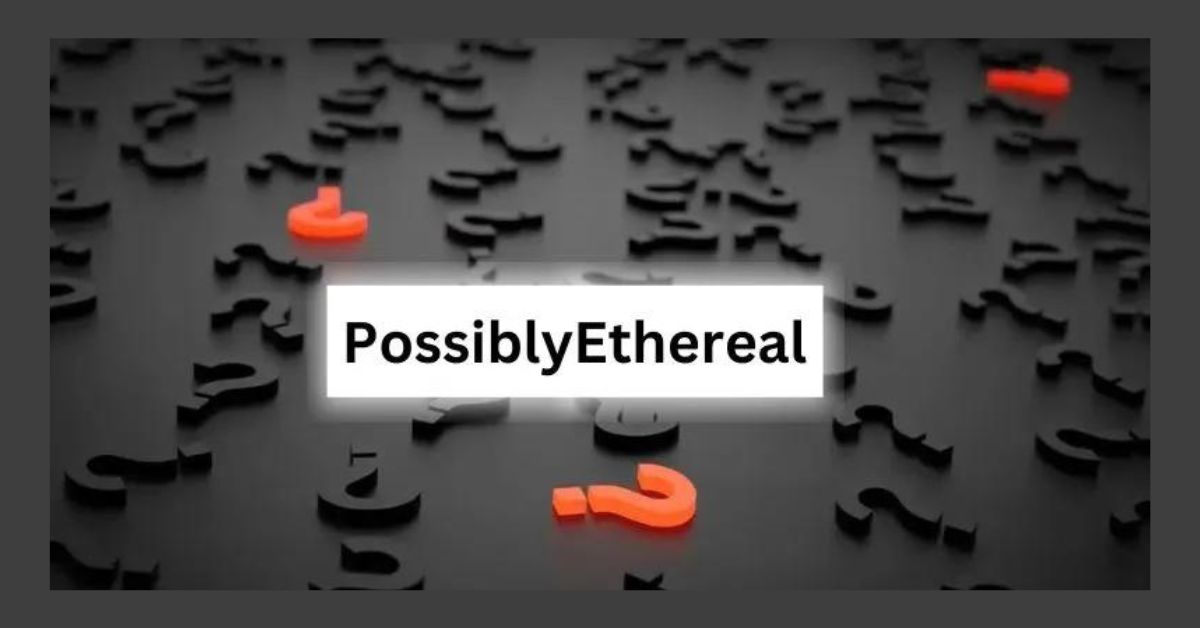Topic
Understanding the Concept of “possiblyethereal”

In the vast landscape of linguistic innovation, one term that has caught the attention of scholars and thinkers alike is “possiblyethereal.” This intriguing term embodies a blend of possibility and ethereality, sparking discussions across various domains.
What is “possiblyethereal”?
“possiblyethereal” encapsulates the essence of something that exists within the realm of possibility, yet its form is ephemeral, transcending conventional boundaries. It represents an idea or concept that possesses the potential for realization but remains elusive and intangible.
Significance of “possiblyethereal”
The significance of “possiblyethereal” lies in its capacity to inspire creativity and imagination. It challenges conventional thinking by offering glimpses into realms beyond tangible reality, fostering innovation and exploration.
Exploring the Historical Context
The roots of “possiblyethereal” can be traced back to ancient philosophical inquiries into the nature of existence and possibility. Visionaries and mystics throughout history have contemplated the interplay between the tangible and the intangible, laying the groundwork for the emergence of this concept.
Real-world Applications
In contemporary society, “possiblyethereal” finds applications in various fields, from art and literature to technology and science. It serves as a catalyst for breakthroughs and innovations, driving progress and pushing the boundaries of human understanding.
Challenges and Criticisms
However, the concept of “possiblyethereal” is not without its challenges and criticisms. Skeptics argue that its elusive nature can lead to ambiguity and uncertainty, hindering practical implementation and understanding.
Future Prospects and Implications
Despite the challenges, the future of “possiblyethereal” appears promising. As technology advances and society evolves, the boundaries between the possible and the ethereal continue to blur, opening new avenues for exploration and discovery.
Examples and Illustrations
To grasp the essence of “possiblyethereal,” one need look no further than the realm of art, where abstract concepts and surreal imagery often evoke a sense of the intangible. Similarly, in the field of quantum mechanics, phenomena such as entanglement and superposition embody the elusive nature of “possiblyethereal.”
Impact on Various Industries
The influence of “possiblyethereal” extends beyond the realms of art and science, permeating various industries such as marketing, design, and entertainment. Companies harness its creative potential to captivate audiences and differentiate themselves in a crowded marketplace.
Strategies for Harnessing the Power
To harness the power of “possiblyethereal,” organizations must embrace innovation and embrace uncertainty. By fostering a culture of experimentation and exploration, they can unlock new opportunities and stay ahead of the curve.
Ethical Considerations
However, ethical considerations surrounding the concept of “possiblyethereal” cannot be overlooked. As technology blurs the lines between reality and fantasy, questions arise regarding the impact on individual autonomy and societal values.
Impact on Society
The widespread adoption of “possiblyethereal” has profound implications for society as a whole. It challenges traditional notions of reality and perception, prompting individuals to question their understanding of the world and their place within it.
Case Studies
Numerous case studies exemplify the impact of “possiblyethereal” on various aspects of human life, from the evolution of storytelling to the development of cutting-edge technologies. These examples highlight the transformative power of imagination and creativity.
The Role of Technology
Technology plays a pivotal role in shaping the concept of “possiblyethereal,” enabling new forms of expression and interaction. Virtual reality, augmented reality, and artificial intelligence offer immersive experiences that blur the boundaries between the real and the imagined.
Conclusion
“possiblyethereal” represents a convergence of possibility and ethereality, inspiring creativity, and pushing the boundaries of human understanding. As we navigate an increasingly complex and uncertain world, embracing the concept of “possiblyethereal” may hold the key to unlocking new realms of possibility and potential.
FAQs
What does “possibly’ethereal” mean?
“possiblyethereal” refers to something that exists within the realm of possibility but remains intangible or elusive.
How is “possibly’ethereal” relevant in today’s world?
In an era of rapid technological advancement and societal change, “possibly’ethereal” serves as a catalyst for innovation and exploration.
Are there any practical applications of “possibly’ethereal”?
Yes, “possibly’ethereal” finds applications in various fields, including art, science, technology, and entertainment.
What are the challenges associated with understanding “possibly’ethereal”?
One of the main challenges is the inherent ambiguity and uncertainty surrounding the concept, which can make it difficult to grasp.
How can individuals and organizations harness the power of “possibly’ethereal”?
By embracing uncertainty, fostering a culture of innovation, and exploring new possibilities, individuals and organizations can leverage the creative potential of “possibly’ethereal” to drive progress and success.

Topic
filmywap
Filmywap – Filmywap bollywood movies download 720p 1080p 480p
Filmywap is the popular destination for all the Filmywap Movie Download
filmywap news – The Indian Express
Filmywap News Updates: Get Latest Breaking News, Photos and Video News on Filmywap. Also find Filmywap latest news headlines, picture gallery, top videos, …
Special: Filmywap – Times of India
Filmywap is a public torrent website which leakes pirated Hindi, English and Punjabi movies online. The website Filmywap uploads the pirated versions of …
Filmywap : Watch Movies & TV – Apps on Google Play
The developer says that this app doesn’t collect or share any user data. Learn more about data safety.
FilmyWap – Apps on Google Play
filmywap (@filmywapmovie) / X
Download free latest Hollywood movies and tv serial online only on filmywap, here you will get full top HD movies list of 2017.
Top 10 Sites for Filmywap Bollywood MP4/MKV Movies Download
Top 10 Sites for Filmywap Bollywood Movies Download · #1 WordFree4U.Trade · #2 A2movies.icu · #3 Okjatt.online · #4 3Movierulz.ms · #5 Skymovieshd.one · #6 …
Filmywap – Facebook
Filmywap, Kathmandu, Nepal. 578 likes · 16 talking about this. it is for film special short video.
Shaitaan (2024)FullMovie Filmywap Free Hindi Download 720p, 480p
Originally starring Lindsay Lohan, Rachel McAdams, Amanda Seyfried, and Lacey Chabert, the first take on Mean’Girls became an instant comedy classic. Shaitaan …
Filmywap (@filmywap.news) • Instagram photos and videos
6 Followers, 1 Following, 11 Posts – See Instagram photos and videos from Filmywap (@filmywap.news)
Filmywap . Website – Facebook
Filmywap . Website. @filmywap.website.2024. Welcome to my world ↪ Attitude Boy ↪ Photoholic ↪ Cricket Lover ↪ Mahakal ka fan ↪. . Went to …
filmywap.com.pe Website Traffic, Ranking, Analytics [February 2024]
filmywap.com.pe is ranked # in US with 0 Traffic. Categories: . Learn more about website traffic, market share, and more!
filmywap – – YouTube
Home. Shorts. Library. #filmywap. 532 videos • 215 channels. All. Shorts. SHORTS · #filmywap #movie #movieshub #love …
filmywap (@wapfilmy1) / X
Return Jatti Happy Gosal Mp3 Song Download Filmywap | @scoopit https://t.co/3p4RFsx95Q.
Filmywap (@filmywap.news) • Instagram photos and videos
6 Followers, 1 Following, 11 Posts – See Instagram photos and videos from Filmywap (@filmywap.news)
Filmywap – TikTok
Topic
Understanding Caste: A Comprehensive Guide

Casteò has been a fundamental aspect of social organization in various cultures throughout history. From ancient civilizations to modern societies, caste systems have shaped the dynamics of communities and influenced individuals’ lives. This comprehensive guide delves into the intricacies of caste, exploring its origins, impact, and contemporary significance.
Caste refers to a social stratification system where individuals are grouped into distinct categories based on birth, occupation, and social status. It has been prevalent in societies across the globe, although its manifestations and complexities vary widely. The concept of caste has deep historical roots and holds significant importance in understanding the social fabric of different cultures.
Origins of Casteò
The origins of caste can be traced back to ancient civilizations such as Mesopotamia, Egypt, and the Indus Valley. These societies developed hierarchical structures based on professions and social roles, laying the foundation for caste systems to emerge. Over time, caste evolved into a complex system of social stratification, particularly prominent in Hinduism and its Varna and Jati systems.
Types of Caste Systems
In Hinduism, the Varna system categorizes individuals into four main groups: Brahmins (priests and scholars), Kshatriyas (warriors and rulers), Vaishyas (merchants and landowners), and Shudras (laborers and service providers). Alongside the Varna system exists the Jati system, which comprises numerous sub-castes or communities based on professions and hereditary occupations. Similar caste-like systems exist in other cultures, each with its own unique characteristics.
Social Hierarchy and Caste
Caste systems are characterized by rigid social hierarchies, where individuals’ status and opportunities are determined by their caste affiliation. These systems often perpetuate inequalities and disparities, with certain castes enjoying privileges while others face discrimination and marginalization. The hierarchical structure of caste influences various aspects of social interactions, including marriage, education, and employment.
Caste Discrimination
Throughout history, caste discrimination has been a pervasive issue, manifesting in various forms of social, economic, and political exclusion. Historical examples include the segregation of Dalits (formerly known as “untouchables”) in India and the marginalization of certain castes in other societies. Despite legal reforms and social movements aimed at addressing caste discrimination, challenges persist, particularly in rural areas and marginalized communities.
Caste in Contemporary Society
In modern times, caste continues to play a significant role in shaping social relations and identities, particularly in South Asia. Legal interventions have sought to address caste-based discrimination and promote equality, yet deeply entrenched social attitudes and practices pose obstacles to meaningful change. The cultural perceptions and attitudes towards caste vary, with some advocating for its preservation as a cultural heritage, while others call for its abolition.
Intersectionality of Caste
Caste intersects with other dimensions of identity, such as gender, race, and socioeconomic status, creating complex layers of privilege and oppression. Women from marginalized castes, for example, face multiple forms of discrimination based on both gender and caste. Similarly, caste-based disparities in education, employment, and healthcare exacerbate socioeconomic inequalities within communities.
Debates and Controversies Surrounding Caste
Academic discourse and political debates surrounding caste often center on questions of social justice, identity politics, and affirmative action. Scholars and policymakers grapple with issues such as caste-based reservations in education and employment, the effectiveness of anti-discrimination laws, and the role of caste in electoral politics. Debates over caste reveal deep-seated divisions within societies and raise questions about the nature of equality and social justice.
Caste and Identity
Caste plays a crucial role in shaping both personal and collective identities, influencing individuals’ sense of belonging and social identity. However, caste-based identity can also be a source of stigma and marginalization, particularly for those from lower castes. Challenges to caste-based identity arise from efforts to promote inclusivity and diversity, challenging traditional notions of purity and hierarchy.
Global Perspectives on Caste
While caste is most commonly associated with South Asian societies, similar forms of social stratification exist in other parts of the world. Comparisons with other systems of social hierarchy, such as race and class, highlight the universality of caste-like structures and the need for global solidarity in addressing caste-based discrimination. International efforts towards caste equality have gained momentum, with organizations advocating for human rights and social justice.
Education and Awareness about Caste
Education and awareness are essential tools in combating caste discrimination and promoting social inclusion. Initiatives aimed at raising awareness about caste-based discrimination and promoting inter-caste dialogue play a crucial role in challenging stereotypes and fostering empathy and understanding. Education empowers individuals to recognize and challenge caste-based inequalities, paving the way for a more equitable and inclusive society.
Future Outlook
The future of caste remains uncertain, with ongoing debates and struggles for social justice shaping its trajectory. While progress has been made in addressing caste-based discrimination, significant challenges remain, requiring sustained efforts from governments, civil society, and communities. The emergence of new social movements and advocacy efforts offers hope for meaningful change, yet the entrenched nature of caste-based inequalities poses formidable obstacles.
Conclusion
understanding casteò is essential for grappling with the complexities of social inequality and injustice. From its ancient origins to its contemporary manifestations, caste has profoundly influenced the lives of millions, shaping identities, opportunities, and social relations. By addressing caste-based discrimination and promoting inclusivity and equality, societies can move towards a more just and equitable future.
FAQs
What is the origin of the caste system?
The caste system has ancient roots, evolving from early forms of social organization in ancient civilizations.
How does caste intersect with other dimensions of identity?
Caste intersects with factors such as gender, race, and socioeconomic status, creating complex layers of privilege and oppression.
What are some examples of casteò discrimination in contemporary society?
Examples include the marginalization of Dalits in India and disparities in education and employment based on caste.
What efforts are being made to address caste-based discrimination?
Legal reforms, social movements, and education initiatives are among the efforts aimed at combating caste discrimination and promoting equality.
What is the future outlook for casteò?
The future of caste remains uncertain, with ongoing debates and struggles for social justice shaping its trajectory.
Topic
Mastering Git Unstage: A Comprehensive Guide to Refining Commits and Managing Changes Efficiently

When it comes to version control systems, Git is unrivaled when it comes to handling project history. Git relies on its staging area, or index, which is an essential component. Before submitting changes to the repository, this staging area is used to arrange the modifications to files. What if, however, you realize after staging certain changes that not all of them should be committed? The idea of “git unstage” is relevant here.
Understanding Git Staging Area
Before delving into “git unstage,” it’s crucial to grasp the concept of the Git staging area. When you make modifications to files in your working directory, Git allows you to stage these changes selectively before committing them. This enables you to craft logical commits, grouping related changes together for clarity and organization.
What Does “Git Unstage” Mean?
“Git unstage” refers to the process of removing changes from the staging area, effectively reversing the action of staging. This operation allows you to reconsider which modifications should be included in the next commit and which ones should be omitted.
Using “git reset HEAD <file>”
One method to unstage changes in Git is by utilizing the “git reset” command followed by the file name. This command effectively resets the staging area for the specified file, leaving the changes unstaged.
Using “git reset HEAD — <file>”
Similar to the previous method, this command resets the staging area for the specified file. However, the double hyphen (–) serves to distinguish the file name from potential branch names, ensuring clarity in command interpretation.
Using “git restore –staged <file>”
Alternatively, you can employ the “git restore” command with the “–staged” option, followed by the file name. This command restores the specified file to its state in the last commit while keeping the modifications in the working directory.
Difference Between “Git Reset” and “Git Restore”
While both “git reset” and “git restore” can be used to unstage changes, they operate differently. “Git reset” modifies the staging area directly, whereas “git restore” manipulates the working directory and staging area separately. Understanding this disparity is crucial for choosing the appropriate command based on your workflow requirements.
Best Practices for Using “Git Unstage”
When employing “git unstage,” it’s essential to follow best practices to maintain a clean and organized repository:
- Review changes thoroughly before staging to minimize the need for unstaging.
- Utilize selective staging to commit logically grouped changes.
- Double-check unstaged files to ensure no unintended modifications are left in the staging area.
Avoiding Unnecessary Unstaging
While “git unstage” provides a convenient means to refine commits, it’s preferable to avoid unnecessary unstaging whenever possible. By adopting disciplined staging practices and committing atomic changes, you can streamline your workflow and minimize the need for extensive unstaging maneuvers.
Common Mistakes to Avoid
In the process of using “git unstage,” beware of common pitfalls that could lead to unintended consequences:
- Unstaging changes without proper review, potentially overlooking critical modifications.
- Unstaging files indiscriminately, resulting in incomplete or inconsistent commits.
- Neglecting to verify unstaged changes before proceeding with the next commit, risking unintended inclusions.
Impact of Unstaging on Git History
Unstaging changes in Git does not directly alter the repository’s history. However, it influences subsequent commits by determining which modifications are included or excluded from each commit snapshot. Understanding the implications of unstaging is essential for maintaining a coherent project history and facilitating collaborative development efforts.
Undoing Git Unstage
If you accidentally unstage changes or realize that unstaging was unnecessary, fear not—Git provides mechanisms for undoing actions. By carefully orchestrating commits, utilizing Git reflogs, or leveraging version control best practices, you can rectify unstaging errors and restore integrity to your repository.
Conclusion
In the dynamic landscape of software development, mastering Git and its nuances is indispensable for efficient collaboration and version control management. Understanding how to effectively utilize commands like “git unstage” empowers developers to refine commits, maintain a clean project history, and mitigate potential errors. By adhering to best practices, avoiding common pitfalls, and embracing the iterative nature of version control, teams can optimize their workflow and accelerate the delivery of high-quality software products.
FAQs
Can I unstage multiple files simultaneously in Git?
Yes, you can unstage multiple files at once by specifying their names in the “git reset” or “git restore” commands, separated by spaces.
Will unstaging changes affect other collaborators working on the same repository?
No, unstaging changes in your local repository does not impact other collaborators until you push those changes to a shared remote repository.
Is there a way to preview unstaged changes before committing them?
Yes, you can use the “git diff” command to view unstaged changes in your working directory before deciding whether to stage or discard them.
Can I undo an unstaging operation after it’s been executed?
Yes, Git provides various methods for undoing actions, including unstaging changes. You can revert to a previous commit, utilize Git reflogs to recover lost commits, or employ other version control strategies to rectify errors.
Are there graphical tools available for managing Git staging and unstaging?
Yes, several graphical user interfaces (GUIs) for Git, such as GitKraken, SourceTree, and GitHub Desktop, offer intuitive interfaces for staging, unstaging, and managing changes visually.
-

 Entertainment5 months ago
Entertainment5 months agoUnveiling the World of HDToday
-

 Technology5 months ago
Technology5 months agoUnveiling the Wonders of Teltlk Technology
-

 Business5 months ago
Business5 months agoUnlocking Opportunities with GovDeals – Liquidity Services Marketplace
-

 Technology5 months ago
Technology5 months agoÇebiti: Corporate Operations with an Integrated AI Platform
-

 Business5 months ago
Business5 months agoThe Ultimate Guide to High Risk Merchant Services
-

 Health5 months ago
Health5 months agoIlluminate Your Scans: Unveiling the Magic of Luminous Scans in Modern Imaging
-

 Entertainment5 months ago
Entertainment5 months agoRecord of the Mightiest Lord Chapter 1: Unveiling the Epic Saga
-

 Health4 months ago
Health4 months agoExploring the Benefits of wellhealthorganic Home Remedies









